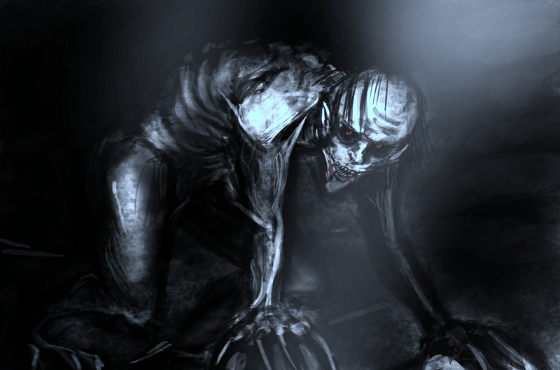What is a Chupacabra? The Chupacabra is a Latin American legendary creature, or cryptid, said to inhabit parts of the Americas. It derives its name from the animal's habit of attacking and drinking the blood of livestock. The name comes from chupar (to suck) and cabra (goat). The first reported attack occurred in March 1995 in Puerto Rico. The creature was described as a goat- or sheep-like creature, of up to 1.8 meters in height, with a long neck, a body covered with thick hair and a bovine head on a cylindrical body.
People who have seen a Chupacabra say it is about 3-4 feet tall, has a row of spines down its back, big red eyes that glow at night with an unusual sheen, clawed hands that are the size of human hands with long fingers and sharp nails. They are often reported to have a low bark, high-pitched voice, and no feet. It is said to kill animals and suck their blood. The creature lurks in the shadows of trees and bushes, and when prey comes by, it grabs it with its long arms, legs, muzzle or tail.
Chupacabra attacks are rare, but the first reports of the creature were made in Puerto Rico. Several alleged sightings have taken place in parts of Texas, New Mexico, Southern California and Mexico. There is also one reported sighting in Canada near Niagara Falls. Many eyewitnesses describe a large hairless animal with bright red eyes attacking livestock without any provocation. The first species to be suggested as a possible ancestor was the extinct giant ground sloth, due to the creatures' apparent physical similarities. Subsequent research has refuted this theory. Chupacabra are one of the most mysterious creatures of our time.
What do Chupacabra sightings look like? The sightings are anecdotal and no physical evidence has been presented to verify the existence of the creature. Cryptozoologists describe the Chupacabra as a separate species of animal, unconnected with any other known predator or cryptid, and attribute its sightings to the westward spread of the coyote through Mexico into the United States. Several people who have seen a Chupacabra say it is about 3-4 feet tall, has a row of spines down its back, big red eyes that glow at night with an unusual sheen, clawed hands that are the size of human hands with long fingers and sharp nails. They are often reported to have a low bark, high-pitched voice, and no feet.
What do Chupacabra attacks look like? The Chupacabra's attacks are usually at night, and many farmers have reported that their livestock disappear overnight only to be found dead the next day. The carcasses are sometimes found with little or no blood in them. Some researchers believe that the eyes of the creature glow red in the dark because it no longer has hair, not because of its inner light source. Many others speculate that it might be some sort of alien predator.
Chupacabra reports are usually preceded by sightings of large coyotes. Could there be more than one creature? While some people think the Chupacabra is simply another name for the coyote, others believe many other animals are responsible. One theory suggests that small dogs, pumas or other predators are responsible, but there has been no evidence to support this claim.
Could there be humans involved in hunting these animals? Some researchers speculate that people could be involved in hunting them down because of their perceived evil behavior. However, many other scientists say that it is likely that the Chupacabras are not being hunted down by humans at all.
Cryptozoologists believe that the Chupacabra crosses back and forth between the American continents. Could there be more than one? Due to the lack of physical evidence, most scientists believe that there is only one Chupacabra. However, some scientists believe that there may be more. One theory suggests that they are intentional cross-breeds created by animal experimentation programs at Area 51 or other similar sites. One researcher, Don Leslie, argues that their origin stems from extraterrestrial intelligence experiments on captive animals.
In conclusion, the scientific community is skeptical that the Chupacabra is a living organism. While some people think that it is a cryptid, most scientists believe that it is an urban legend. However, there are some scientists who do believe in the creature, and they will go to great lengths to prove its existence. If or when more evidence for it appears, I will re-write this post with a new title and update this list with this new information.


